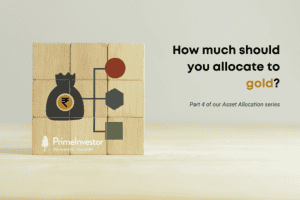Global stock markets have rallied furiously in the past few weeks on hopes that Covid may be vanquished by a vaccine, with Russia claiming success with its Sputnik V, the UK clearing Pfizer’s vaccine and three other vaccines entering late stage clinical trials. A few high frequency indicators from around the world on manufacturing and home sales have also raised expectations for economic activity to normalise quickly post-Covid.

These developments have led to a sudden waning of global investor interest in gold, sought after as a safe haven. Global gold prices, after hitting a lifetime high of $2067/troy ounce in early August have slumped 12% to $1822 by December 3. Indian gold prices at Mumbai, after soaring to Rs 58015 per 10 grams during the same period have cooled off 13% to Rs 50850 now. Gold ETFs and open-end gold funds investing in them, have therefore seen their NAVs drop accordingly. Gold ETFs have seen 14-15% declines in market prices.
We believe this correction offers a good opportunity for Indian investors to accumulate gold. In our previous articles, we had explained why investors need to allocate upto 10% of their portfolio to the precious metal, as portfolio insurance. (Read about our gold outlook here and what to expect from gold here)
Why own gold at all?
The rationale for Indian investors to own gold is threefold:
# 1 A rolling return analysis of Indian gold prices since January 1990 shows that gold for Indian investors has averaged a 9-10% returns for holding periods of 3, 5 and 10 years. This return profile makes a case for having an allocation to gold.
#2 Despite these averages, gold often does nothing for long periods of time. The rolling return analysis shows that with 1, 3 and 5-year holding periods gold has delivered losses or sub-par returns (below 5 %) about 35% of the time. This tendency to remain dormant argues for not holding too much gold in your portfolio. Gold cannot replace wealth-generating assets like equities or even bonds which offer consistent compounding from earnings or interest.
# 3 When gold does perform, it surprises you with sharp and very profitable rallies. These rallies, going by history, have usually occurred during global crises- oil price shocks, runaway inflation, geopolitical tensions (the Gulf War) or financial market turmoil (global financial crisis). Because gold carries a low to negative correlation with both bonds and stocks and performs when they lag, it cushions your portfolio returns during crises.
In India, gold performs a dual role as portfolio insurance. Apart from soaring when the stock markets melt down, gold delivers positive returns from Rupee depreciation too. In India, economic crises usually see foreign investors stampeding out and triggering sharp bouts of Rupee depreciation against the dollar. Such depreciation adds directly to your returns as a gold investor. In the last twenty years, Rupee depreciation against the dollar has added about 3 percentage points annually to returns of Indian gold investors.
The following table highlights how gold ETFs in India fared during bear markets for stocks like 2008 and 2011.
Why now?
Okay, accepting that an allocation to gold does make sense for long-term investors in India, why is now a good time to accumulate it? The reasons are fourfold.
# 1 Overheated equities
Indian stock market valuations were a little too warm for comfort even before Covid, but they’ve turned super-heated after the rally. The Nifty50 PE multiple was at 29 times standalone earnings and about 26 times consolidated earnings in December 2019, already higher than the long-term average of 18 times. After correcting nicely to about 17 times in March, however, the Nifty’s standalone PE has soared to over 36 times now.
History tells us that such valuations often presage bubbles. The dotcom bubble burst in February 2000 when the Nifty50’s PE was 27 times. The global financial crisis triggered a meltdown when the Nifty50’s PE was at over 26 times in 2008. These are standalone PEs. Even if you take Nifty50’s consolidated earnings at Rs 455 for FY21 and Rs 650 for FY22, these translate into a Nifty50 forward PE of 28 times and 20 times respectively. Such valuations assume blockbuster earnings growth post-Covid. If it doesn’t materialise, the resulting correction can be quite painful. Check this chart for our Nifty50 heatmap.
# 2 Shaky rebound
While high frequency indicators and listed companies’ 30 per cent profit growth for Q2 FY21 have raised hopes for a V shaped recovery, it is not a certainty that India can get back to a 8% growth trajectory on a pre-Covid base and that profit growth can sustain this scorching pace once the low base effect wears off.
High frequency indicators such as manufacturing PMI, IIP and auto sales have been influenced by one-off factors such as pent-up demand, the festive season and channel stuffing by manufacturers, which can wane by January. A vaccine alone may not enough to the undo the damage to incomes and consumer confidence wrought by Covid.
Profit growth for listed companies has been propped up by sharp cutbacks in overheads, benign input prices (read our analysis on this here) and the new corporate tax regime in Q2, even as sales growth has been muted. Sustainable profit growth can come only from traction in topline growth. This strengthens the case for a correction too.
# 3 Bullish bonds
Along with stock prices, bond prices in India have also seen an unprecedented rally with the RBI/MPC steadily pruning policy rates for the last six years and taking them to the lowest levels in three decades. The repo rate between January 2014 and now has seen a 400-basis point cut, taking it from 8 % to 4 %.
With RBI supplementing the MPC’s efforts with large liquidity injections by way of open market operations, Operation Twist, dollar buying and what-not, market interest rates in India today are ruling well below repo rates for large borrowers. Both the rate cuts and RBI’s easy money policies ignore rising CPI inflation. Any normalisation of these record low rates will de-rate stock valuations and cut the bond rally short, precipitating a correction in both asset classes.
# 4 Relying on stimulus
The tidal wave of liquidity unleashed by global central banks in the name of rate cuts and prolonged near-zero or negative rates in the developed world have both contributed in no small way to the concerted rally in both stocks and bonds across the world. Market pundits in fact have now given up on providing fundamental justifications for both the high stock valuations and the irrational appetite for junk bonds globally and are predicating their arguments mainly on the continuation of stimulus. The continuation of this rally therefore hinges greatly on the actions of central bankers and their willingness to continue with this game of who blinks first.
While markets can certainly remain irrational longer than one can remain solvent, if one has participated in this rally and pocketed stellar gains, it makes sense to reduce weights in your outperforming assets and to increase it in a recently underperforming one such as gold.
Yes, given that liquidity has lifted all asset classes, even gold prices are likely to give way initially if central banks pause in their money-printing efforts. But then, gold dons many hats in the investment context. It is a defence against a debasement of paper money, a hedge against inflation and a handy asset for central banks looking to diversify from King Dollar. The multiple roles can help gold stage a comeback from any global asset meltdown, while stocks and bonds are still reeling.
How to do it
If you have no allocations to gold in your portfolio right now, you can accumulate gold at current levels to take your exposure to 5%. If you already own a 5% exposure, this is an opportune time to add tactical allocations of up to 10 %. Instead of investing all your surpluses at one go, phased purchases in 2 tranches would be wise.
Of all the available choices to own gold, we think Sovereign Gold Bonds issued by the government of India and Gold ETFs offered by mutual funds are the most cost effective and efficient (digital gold loses out as it is unregulated). However, SGB issues are timed to the government’s convenience and not to yours.
The 5-year lock in and poor secondary market liquidity can make a timely exit difficult. So instead of waiting for the next tranche of SGBs to open on December 28, it would be best to buy gold ETFs or gold funds based on ETFs, if you don’t own a demat account.
If you are looking for ETFs, check our Prime ETFs for the 2 gold ETF options we have. With gold funds, go with those schemes with Prime Ratings of 4.5 and above to ensure minimal tracking error and cost.







50 thoughts on “Is it time to buy gold?”
Thanks, Aarti. A couple of questions:
1. How does e-gold offered by NSEL stack up as an option to gold ETFs? They have very less brokerage fees, this return can be higher.
2. Do you know which brokerage firms allow you to buy e-gold and e-silver? Most of the commonly known broker firms aren’t registered with NSEL?
Thanks again.
NSEL in my view was shut down after a scam involving it’s commodity trades. Don’t think egold and esilver options are available today.
oh ok, thanks for the update. Is there any way available now to invest in silver in paper form? Hopefully, AMC are thinking to plug this gap sooner than later.
Only through silver futures on MCX. Yes AMCs need to float silver ETFS!
Hi Mam ,
A slight offbeat clarification with this subject article.
1, Would be a smart idea to diversify in Silver , in case we already have a 5% gold in the portolio.
2, Are there any funds that available in india for investors such as silver funds or an silver Etf .
Silver does outperform gold in its bull phases but is influenced by economic prospects given its industrial uses. Unfortunately no fund or ETF to buy silver. Need to do it via futureson mcx.
Great Article. I’m quite seriously thinking about in vesting in Gold via the MF route.
One lingering question:
From you analysis based on gold prices: “The rolling return analysis shows that with 1, 3 and 5-year holding periods gold has delivered losses or sub-par returns (below 5 %) about 35% of the time. ” . I suppose this is the case for data since 1990.
When I look at the data for Gold MF from 2011 – 2021, I see that nearly 50% of the time 5 year rolling seems to be negative returns. Above 5% returns occur only about 30% of the time despite last year. I’m worried that the averages aren’t stable enough to draw inferences. But I do want to invest in gold considering the state of other options, just as you have highlighted in your article.
What in your view would be a good holding period for gold?
Hello sir,
Not sure what data you are looking at…while gold has certainly been a poor returner before the 2019 rally, the metal was not delivering losses on a 5-year basis that frequently. The case for gold, in any case, is for the huge rallies it gives when equity corrects. This is the period when returns come in. Please refer to this article for how to use gold in your portfolio: https://primeinvestor.in/what-can-you-expect-from-gold-returns-data-says/
Thanks,
Bhavana
This may be true as it would exclude the 2007 to 2014 bullion rally. Gold cycles tend to be quite long so 10 year exp may be too.short for inferences. Short holding periods may deliver if you can foresee risks to stocks or bonds. But as black swan events like Covid cause max damage best to own constant allocation until goal is reached.
Well timed research call Aarati mam. Thank you
1. Would you recommend buying SGB from the Secondary markets? For Example, the Aug2020 Tranche is now available at around INR 4900 per unit versus an issue price of almost INR 5284 per unit. I am looking to buy from Secondary market & hold till maturity.
2. Are there any risk of buying from secondary market if one is looking to hold till maturity?
1. Entirely your call sir.
2. If you get your buy price closer to gold price (liquidity is optimal), not much.
Thanks Vidya. If you buy from secondary market and hold for 3 years or more till maturity, is the capital gains exempted from tax?
No, you need to hold SGBs until maturity to have the capital gains exempt. If you exit by selling in the secondary market, capital gains will be taxed.
Thanks,
Bhavana
In fact, my question is if we BUY from secondary market and hold it for more than three years till maturity, is capital gains exempt from tax?
Hello sir,
As long as you hold the instrument till maturity, it will be exempt from capital gains tax whether you buy from the secondary market or at the initial issue. The 3-year rule does not apply here. If you exit in the secondary market, then the normal 3-year rule applies.
Thanks,
Bhavana
Is it right that there is no capital gains tax in SGB, but there is capital gains tax with indexation in ETF Gold?
There is no capital gains in Sgb if you hold on till maturity. Secondary mkt exit is subject to capital gains tax.
Appreciate, if you can provide information on comparative advantages and disadvantages of SGB issued by GOI and Gold ETFs of Mutual Funds.
Regards,
Venkatesh
Kindly read the details here https://primeinvestor.in/sovereign-gold-bonds-or-etfs-which-is-the-better-gold-investment/
I see your ratings but which Gold fund is best on a) minimum tracking errors to gold price b) total expense ratio ( considering that investor is not only paying for fund expenses but also ETF cost which is held by the fund)?
Total expense ratio in fofs includes the cost of underlying fund
Thanks
I researched this. The gold FoF cost does not include the cost of gold ETF.
Your question is not clear. The NAV of a gold ETF is after TER. So naturally when the FOF buys into a gold ETF, the cost is already recognised in the NAV of the ETF.thanks, Vidya
Which is the most relevant gold price chart to watch? The cycles seen in a chart indicates where we are currently in the cycle. It would have been helpful if you added a chart to the article. Thanks for these tactical calls.
Gold prices from Mumbai Billion Association. But the data is not easy to get and we don’t have the copyright to use it. You can use lbma gold prices as the trends carry high correlation.
I’ve bought SGB during trading days at about Rs.300 lesser than the issue price in secondary market. One could try this option. Thought this could help others who plan to buy. The advantage also is if you get lucky buying an older bond whose 5-year exit window or the 8-year maturity window is shorter compared to buying fresh SGB. In fact I would suggest not to buy the fresh SGBs but go always for secondary market.
Comments are closed.